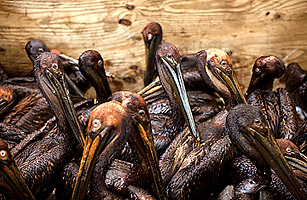
I. The Impact: On the Oily Coast
Terry Vargas is living with the oil. Nearly three weeks ago, the third-generation shrimper pulled into port in Grand Isle, in southeast Louisiana, with a catch worth $1,400. But that was before authorities closed the rich Delta waters to fishing, thanks to the massive oil spill that has swamped the shoreline. Like many furloughed Louisiana fishermen, Vargas took a check from BP — part of the energy giant’s promise to Gulf Coast residents to “make things right” in the wake of the biggest environmental disaster in U.S. history. It was for $5,000, an amount Vargas says he can make in two nights during a good shrimping season. Still, $5,000 is better than nothing, but Vargas knows it won’t cover his expenses now or in the uncertain weeks ahead. So he has taken on carpentry jobs — the only paying work he can find — and today is building a small shed among the houses on Grand Isle, many of which stand on stilts, stork-like, to endure the inevitable floods.
Vargas thinks about the hurricane season that began on June 1 — forecasters predict a major one — and remembers when Katrina hit and left a pile of sand in his living room. Hurricanes pass; people evacuate, and then they rebuild. But the spill is a disaster of a different kind. He worries about a storm hitting the oily waters, raining crude on his hometown. “If that oil comes ashore,” Vargas says, “it’s all over.”
More than a month and a half after the Deepwater Horizon rig exploded, the vast oil spill it triggered — an estimated 50 million gal. of crude lost, if not far more — entered a new phase. For the first time there was genuine, sustained success in controlling the leak 5,000 ft. below the Gulf of Mexico’s surface. After top kills and junk shots failed, BP’s underwater robots sheared off part of the mangled riser pipe and placed a containment cap over the leak, diverting up to 15,000 bbl. of oil a day that would have otherwise bled away.
Yet that engineering achievement seemed hollow. The containment cap is essentially an inverted bucket with several holes in it, carrying oil up to a collection ship through a pipe. Some oil will continue to gush out until at least August, when relief wells will finally kill the spill. In the meantime, oil will keep hitting the sensitive shorelines of the Gulf states, poisoning wildlife and destroying livelihoods. The spill is “an insidious enemy,” said Coast Guard Admiral Thad W. Allen, the top federal official on the response. “This is a long campaign, and we’re going to be dealing with this for the foreseeable future.”
As that realization sank in — that this will be the summer of the spill — public shock turned to anger, fueled by the first iconic images of oil-drenched birds and turtles. Most of that anger was directed at BP, the energy giant chiefly responsible for the spill and, perversely, for cleaning it up. An Internet campaign sprang up to boycott the company’s gas stations, while activists in Washington called for the citizen’s arrest of BP’s gaffe machine of a CEO, Tony Hayward, who blurted out that he would just “like [his] life back” — something he has in common with the 14 million residents of the Gulf Coast. Even when the company did something right, it couldn’t do it right: for every 15,000 bbl. of oil that make it to the collection ship through the containment cap, perhaps 10,000 still leak away in the deep, and possibly far more. The ship must process what it collects before it can be stored, separating oil from gas from seawater, and it’s limited in how much it can handle.
President Barack Obama — criticized for being too cool in a crisis — has begun to reflect America’s rage. “I don’t sit around talking to experts because this is a college seminar,” he told the Today show on June 7. “We talk to these folks because they potentially have the best answer, so I know whose ass to kick.”
There’s plenty of ass-kicking to go around. The Deepwater Horizon spill was also a regulatory failure, one that was a long time coming. The Minerals Management Service , the Interior Department agency meant to oversee offshore drilling, did far too little for far too long, creating a laissez-faire atmosphere in which a major accident was just waiting to happen. Though MMS’s lax oversight dates back to its creation in 1982 by Interior Secretary James Watt, a disciple of deregulation, Obama and his team did too little to clean house when they took over — just as they’ve been too slow to seize control over the spill response from BP.
See the world’s top 10 environmental disasters.
Watch TIME’s video “The Oil Spill by the Numbers.”